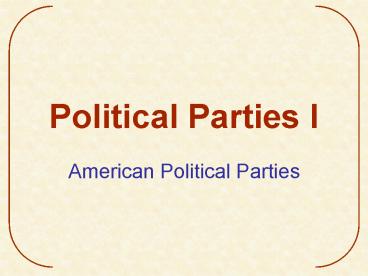Political Parties I - PowerPoint PPT Presentation
1 / 9
Title:
Political Parties I
Description:
Created the Democratic-Republican Party (now the Democrats) ... national parties (Republican National Committee, Democratic National Committee) ... – PowerPoint PPT presentation
Number of Views:1657
Avg rating:3.0/5.0
Title: Political Parties I
1
Political Parties I
- American Political Parties
2
Purpose
- Political Parties not mentioned in the
Constitution. - Not anywhere!
- Not at all!
- All Politics Is Collective Action
- Parties organize people for electoral success.
- History
- Between 1789 1800, Northeasterners, led by
Alexander Hamilton, formed a cohesive voting bloc
in Congress. President John Adams was aligned
with them. - Thomas Jefferson, James Madison, and other
Southerners despised them, so they organized an
opposition of candidates and voters. - Created the Democratic-Republican Party (now the
Democrats). - Their organizing/collective action efforts were
successfulthey took over the Congress and
presidency.
3
Realignment--Dealignment
- Your book gives history of the party system.
- This is a history of realignment, moments when
there was a large shift of support from one party
to another. - Last big realignment was 1932, Democrats whupped
the Republicans, and dominated until 1980s/1990s. - Dealignment Whats happening nowpeople leaving
the parties w/o joining another party. - Far fewer people identifying with any party now.
4
Party Organization
- U.S. parties are not top-down, but bottom-up.
- The most basic unit is the precinct office.
- A precinct is the area surrounding one polling
station. - Above that is the crucial county party office.
- Above that is the state party, perhaps the most
important unit. - The national parties (Republican National
Committee, Democratic National Committee) are
conglomerations of state parties. - E.g., Minnesota has no Democratic Party It has
the Democratic-Farmer-Labor Party (DFL).
5
Regulated by States (Federalism at work)
- Some states make it difficult to become an
official political party, some make it easy. - Cross-nomination Can nominate another partys
candidate as your own. - NY allows this, so has more political parties
than any other state. - For example, Ralph Nader was a candidate, in
various states, for the Populist Party, the
Populist Party of Arkansas, the Colorado Reform
Party, the Independent Party of Delaware, the
Reform Party, The Better Life Party, the
Independence Party, and the Peace and Justice
Party - What principle of politics is at work here?
6
Who are the Republicans?
- But theyre not all the same
- Pro-business Republicans
- Believe in free markets (or perhaps govt
subsidies to support business) and low taxes.
Less concerned about social issues. - Social Conservatives
- Believe social issues are most crucial. May
oppose free market policies such as NAFTA and WTO
because they fear social upheaval. - Libertarian Republicans
- Skeptical about all govt regulation. (Some join
Libertarian Party, but it only gets 1 of vote.)
- A Republican voter is more likely to be
- White
- Male
- Conservative
- Southern
- Against economic regulation
- Minimum wage laws, environmental regulation, etc.
- In favor of social regulation
- Banning gay marriage, censoring pornography,
keeping drugs illegal.
7
Who are the Democrats?
- A Democratic voter is more likely to be
- Non-white
- But, most Democrats are white.
- Female
- Liberal
- From the Northeast or West Coast
- But they have divergent blocs
- African-Americans
- Labor
- Environmentalists
- Social liberals
8
Regional Changes?
9
(No Transcript)































